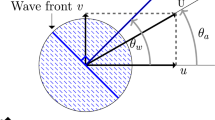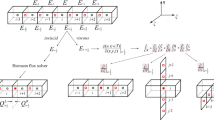Abstract
In this work, we have proposed two new combined compact difference (CCD) schemes for the solution of Navier–Stokes equations. These spatial discretization schemes have not only high spectral resolution for obtaining first and second derivative terms, but also have improved dispersion relation preserving properties when the fourth-order four-stage Runge–Kutta scheme is used for time integration. Out of the two proposed CCD schemes, the first scheme has upwind stencil, while the second scheme has a central stencil. Important numerical properties of these schemes have been analyzed and their effectiveness have been shown by solving the model wave equations, as well as Navier–Stokes equations. Results show that the upwind CCD scheme is suitable for high accuracy large eddy simulation of transitional and turbulent flowfields.


















Similar content being viewed by others
References
Chiu, P.H., Sheu, T.W.H.: On the development of a dispersion-relation-preserving dual-compact upwind scheme for convection-diffusion equation. J. Comput. Phys. 228, 3640–3655 (2009)
Sengupta, T.K., Dipankar, A., Sagaut, P.: Error dynamics: beyond von Neumann analysis. J. Comput. Phys. 226, 1211–1218 (2007)
Tam, C.K.W., Webb, J.C.: Dispersion-relation-preserving finite difference schemes for computational acoustics. J. Comput. Phys. 107, 262–281 (1993)
Lele, S.K.: Compact finite difference schemes with spectral-like resolution. J. Comput. Phys. 103, 16–42 (1992)
Sengupta, T.K., Ganeriwal, G., De, S.: Analysis of central and upwind compact schemes. J. Comput. Phys. 192, 677–694 (2003)
Sengupta, T.K., Sircar, S.K., Dipankar, A.: High accuracy schemes for DNS and acoustics. J. Sci. Comput. 26, 151–193 (2006)
Weinan, E., Liu, J.G.: Essentially compact schemes for unsteady viscous incompressible flows. J. Comput. Phys. 126, 122–138 (1996)
Meitz, H.L., Fasel, H.F.: A compact-difference scheme for the Navier–Stokes equations in vorticity-velocity formulation. J. Comput. Phys. 157, 371–403 (2000)
Lee, C., Seo, Y.: A new compact spectral scheme for turbulence simulations. J. Comput. Phys. 183, 438–469 (2002)
Nagarajan, S., Lele, S.K.: A robust high order compact method for large eddy simulation. J. Comput. Phys. 191, 392–419 (2003)
Park, N., Yoo, J.Y., Choi, H.: Discretization errors in large eddy simulation: on the suitability of centered and upwind biased compact difference schemes. J. Comput. Phys. 198, 580–616 (2004)
Zhong, X.: High-order finite-difference schemes for numerical simulation of hypersonic boundary-layer transition. J. Comput. Phys. 144, 662–709 (1998)
Sengupta, T.K., Rajpoot, M.K., Bhumkar, Y.G.: Space-time discretizing optimal DRP schemes for flow and wave propagation problems. Comput. Fluids 47, 144–154 (2011)
Ekaterinaris, J.A.: Implicit, high-resolution compact schemes for gas dynamics and aeroacoustics. J. Comput. Phys. 156, 272–299 (1999)
Shang, J.S.: High-order compact-difference schemes for time-dependent maxwell equations. J. Comput. Phys. 153, 312–333 (1999)
Zhou, Q., Yao, Z., He, F., Shen, M.Y.: A new family of high-order compact upwind difference schemes with good spectral resolution. J. Comput. Phys. 227, 1306–1339 (2007)
Mahesh, K.: A family of high order finite difference schemes with good spectral resolution. J. Comput. Phys. 145, 332–358 (1998)
Dipankar, A., Sengupta, T.K.: Symmetrized compact scheme for receptivity study of 2D transitional channel flow. J. Comput. Phys. 215, 245–273 (2006)
Sengupta, T.K.: High Accuracy Computing Methods: Fluid Flows and Wave Phenomena. Cambridge University Press, Cambridge, MA (2013)
Chu, P.C., Fan, C.: A three-point combined compact difference scheme. J. Comput. Phys. 140, 370–399 (1998)
Sengupta, T.K., Lakshmanan, V., Vijay, V.V.S.N.: A new combined stable and dispersion relation preserving compact scheme for non-periodic problems. J. Comput. Phys. 228, 3048–3071 (2009)
Sengupta, T.K., Vijay, V.V.S.N., Bhaumik, S.: Further improvement and analysis of CCD scheme: dissipation discretization and de-aliasing properties. J. Comput. Phys. 228, 6150–6168 (2009)
Arakawa, A.: Computational design of long term numerical integration of the equations of fluid motion: two-dimensional incompressible flow. J. Comput. Phys. 1, 119–143 (1966)
Kennedy, C.A., Gruber, A.: Reduced aliasing formulations of the convective terms within the Navier–Stokes equations for a compressible fluid. J. Comput. Phys. 227, 1676–1700 (2008)
Kirby, R.M., Karniadakis, G.E.: De-aliasing on non-uniform grids: algorithms and application. J. Comput. Phys. 191, 249–264 (2003)
Sengupta, T.K., Bhaumik, S., Bhumkar, Y.G.: Direct numerical simulation of two-dimensional wall-bounded turbulent flows from receptivity stage. Phys. Rev. E. 85, 026308 (2012)
Sengupta, T.K., Nair, M.T.: Upwind schemes and large eddy simulation. Int. J. Numer. Methods Fluids 31, 879–889 (1999)
Lesieur, M., Metais, O.: New trends in large eddy simulation of turbulence. Annu. Rev. Fluid Mech. 28, 45–82 (1996)
Sengupta, T.K., Dipankar, A.: A comparative study of time advancement methods for solving Navier–Stokes equations. J. Sci. Comput. 21, 225–250 (2004)
Sengupta, T.K., Bhumkar, Y.G., Rajpoot, M., Suman, V.K., Saurabh, S.: Spurious waves in discrete computation of wave phenomena and flow problems. Appl. Math. Comput. 218, 9035–9065 (2012)
Sheu, T.W.H., Chiu, P.H.: A divergence-free-condition compensated method for incompressible Navier–Stokes equations. Comput. Methods Appl. Mech. Eng. 196, 4479–4494 (2007)
Green, S.I.: Fluid Vortices: Fluid Mechanics and Its Applications. Springer, Berlin (1995)
Ghia, U., Ghia, K.N., Shin, C.T.: High-Re solutions for incompressible flow using the Navier–Stokes equations and a multigrid method. J. Comput. Phys. 48, 387–411 (1982)
Botella, O., Peyret, R.: Benchmark spectral results on the lid-driven cavity flow. Comput. Fluids 27, 421–433 (1998)
Bruneau, C.-H., Saad, M.: The 2D lid-driven cavity problem revisited. Comput. Fluids 35, 326–348 (2006)
Peng, Y.F., Shiau, Y.H., Hwang, R.R.: Transition in a 2D lid driven cavity flow. Comput. Fluids 32, 337–352 (2003)
Clercx, H.J.H., Maassen, S.R., van Heijst, G.J.F.: Decaying two-dimensional turbulence in square containers with no-slip or stress-free boundaries. Phys. Fluids 11, 611–626 (1999)
Clercx, H.J.H., van Heijst, G.J.F.: Energy spectra for decaying 2D turbulence in a bounded domain. Phys. Rev. Lett. 85, 306–309 (2000)
Sengupta, T.K., Singh, H., Bhaumik, S., Chowdhury, R.R.: Diffusion in inhomogeneous flows: unique equilibrium state in an internal flow. Comput. Fluids 88, 440–451 (2013)
Braccoa, A., McWilliams, J.C., Murante, G., Provenzale, A., Weiss, J.B.: Revisiting freely decaying two-dimensional turbulence at millennial resolution. Phys. Fluids 12, 2931–2941 (2000)
Lo, D.C., Murugesan, K., Young, D.L.: Numerical solution of three-dimensional velocity–vorticity incompressible Navier–Stokes equations by finite difference method. Int. J. Numer. Methods Fluids 47, 1469–1487 (2005)
Ding, H., Shu, C., Yeo, K.S., Xu, D.: Numerical computation of three-dimensional incompressible viscous flows in the primitive variable form by local multiquadric differential quadrature method. Comput. Methods Appl. Mech. Eng. 195, 516–533 (2006)
Acknowledgments
This work was supported by the National Science Council of the Republic of China under Grant 101R891002. We are thankful to Prof. Tapan K. Sengupta for his valuable suggestions in the preparation of this manuscript.
Author information
Authors and Affiliations
Corresponding author
Appendix
Appendix
In this section, we have provided the steps while developing an upwind combined compact difference scheme. The first and the second derivative terms (\(\frac{\partial u}{\partial x}\) and \(\frac{\partial ^2 u}{\partial x^2}\)) are approximated as
Here, we have used a central stencil to approximate the second-order derivative term. Taylor series expansion has been used to obtain the coefficients shown in (31), which results in a sixth-order accurate stencil based on the leading truncation error term. Coefficients in Eq. (30) are obtained by applying the Taylor series expansion for the terms \(u_{i-1},\,u_{i+1},\,\frac{\partial u}{\partial x}|_{i-1},\,\frac{\partial u}{\partial x}|_{i},\,\frac{\partial u}{\partial x}|_{i+1},\,\frac{\partial ^{2} u}{\partial x^{2}}|_{i-1},\,\frac{\partial ^{2} u}{\partial x^{2}}|_{i}\) and \(\frac{\partial ^{2} u}{\partial x^{2}}|_{i+1}\) with respect to \(u_i\).
In Eq. (30), there are in total eight unknown coefficients. Elimination of the leading truncation error terms gives the following set of seven algebraic equations.
Derivation of one more algebraic equation is needed to determine all the eight coefficients in Eq. (30) uniquely for \(\frac{\partial u}{\partial x}|_{i}\). The first-order derivative term in Eq. (30) can be better approximated if the dispersive nature of the term \(\frac{\partial u}{\partial x}\) is well retained [1].
The expressions of the actual wavenumber for Eqs. (30) and (31) can be derived as
While approximating the first-order derivative term, dispersion error is minimized if the exact and the numerical wavenumbers are matched excellently over a complete wavenumber range. This amounts to equating the effective wavenumbers \(\alpha ^{'}\) and \(\alpha ^{''}\) to those shown in the right-hand sides of Eqs. (41) and (42) [1]. Thus, we obtained following two equations
Equations (41) and (42) are solved to get the expression for \(\alpha ' h\) which has been used subsequently to minimize the dispersion error. This expression for \(\alpha ' h\), which is in general complex with the real and imaginary parts of the numerical modified wavenumber \(\alpha 'h\), provides information regarding the dispersion error (phase error) and the dissipation error (amplitude error), respectively. For getting better dispersive accuracy of \(\alpha '\), the value of \(\alpha h\) should be closer to \(\mathfrak {R}[\alpha ' h]\), where \(\mathfrak {R}[\alpha ' h]\) denotes the real part of \(\alpha ' h\). Thus the error function \(E(\alpha )\) as defined below should be very small. It has been evaluated over the integration range given below as
To make the error function defined in \(0\le \alpha h\le \frac{7\pi }{8}\) to be positive and minimal, the extreme condition \( \frac{\partial E}{\partial c_{3}} = 0\) is enforced to minimize the numerical wavenumber error. This constraint equation has been used together with previously derived seven algebraic equations to obtain all the eight unknowns. The resulting eight introduced unknown coefficients can be uniquely determined as
For \(u<0\), the proposed three-point stencil non-centered combined compact difference scheme can be similarly derived below for the approximation of the derivative term \(\frac{\partial u}{\partial x}\)
One should pay a careful attention to the following important points. Significant improvements in spectral resolution as shown in Fig. 1e and the DRP region shown in Fig. 5 are possible using a small stencil because we have derived the scheme for first and second derivatives in a coupled fashion. The expression for \(\alpha ^{'} h\) is derived by considering Eqs. (41) and (42) together. Figure 1f shows that efficiency in the evaluation of the second derivative is very close to the exact value. Thus, while designing CCD schemes, use of one optimization equation given by \( \frac{\partial E}{\partial c_{3}} = 0\) is justified.
Rights and permissions
About this article
Cite this article
Yu, C.H., Bhumkar, Y.G. & Sheu, T.W.H. Dispersion Relation Preserving Combined Compact Difference Schemes for Flow Problems. J Sci Comput 62, 482–516 (2015). https://doi.org/10.1007/s10915-014-9864-7
Received:
Revised:
Accepted:
Published:
Issue Date:
DOI: https://doi.org/10.1007/s10915-014-9864-7




